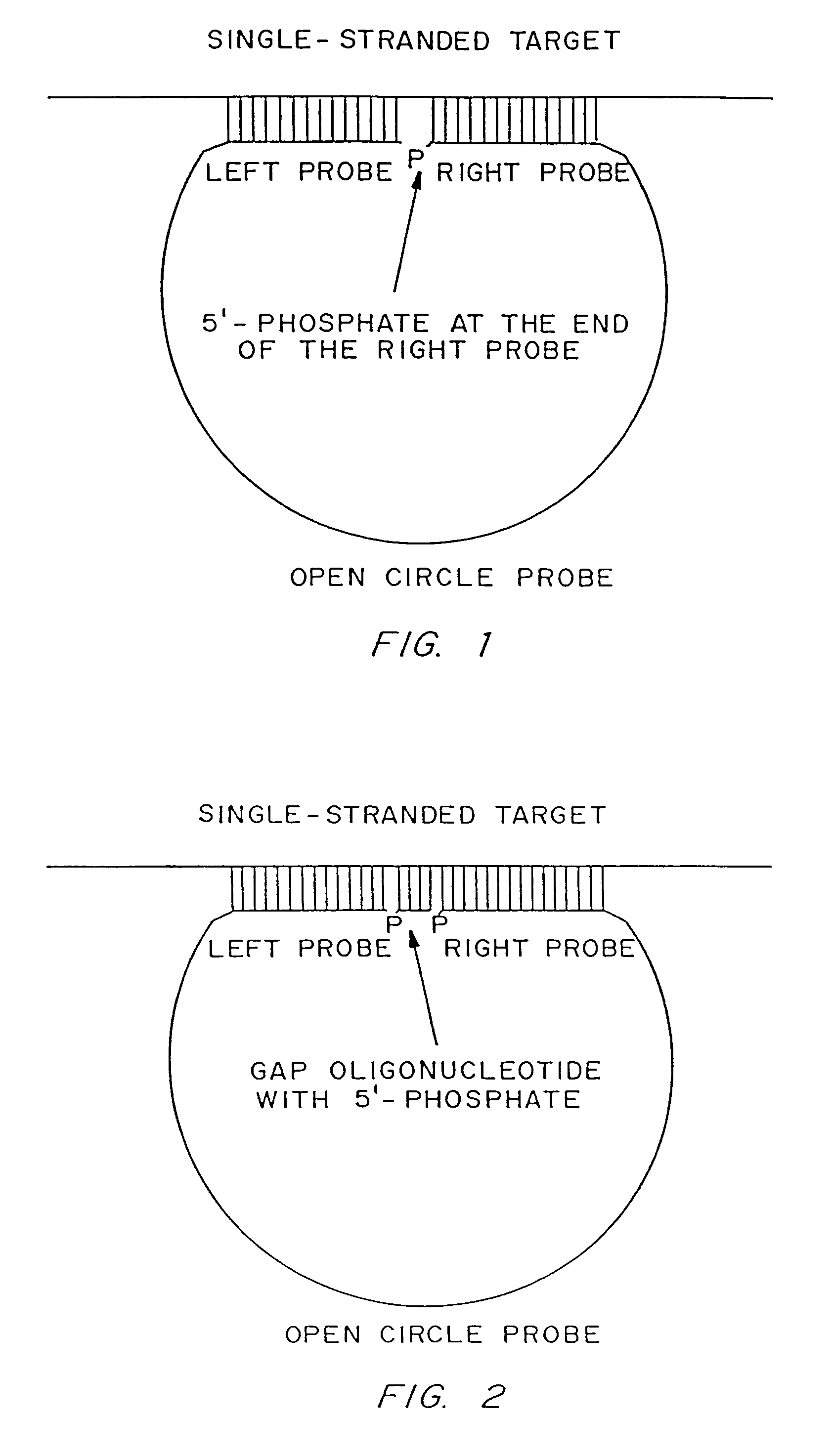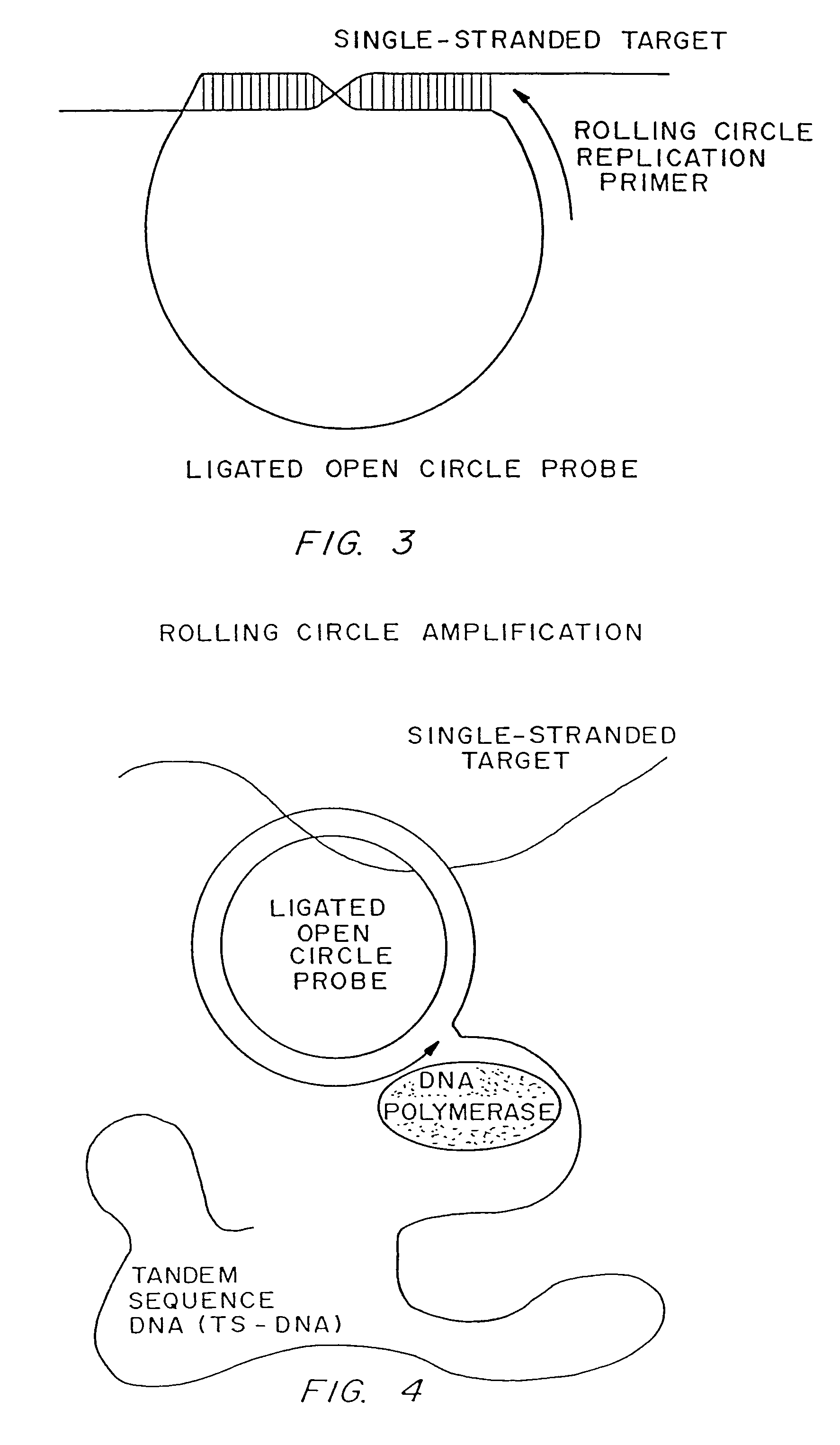Rolling circle replication reporter systems
a reporter system and rolling circle technology, applied in the field of nucleic acid amplification and detection, can solve the problems of lack of precision, low quantitative measurement relative precision, data obtained using multiplexing, etc., and achieve the effect of less complicated amplification and more consistent outpu
- Summary
- Abstract
- Description
- Claims
- Application Information
AI Technical Summary
Benefits of technology
Problems solved by technology
Method used
Image
Examples
example 1
Target-mediated Ligation of Open Circle Probes and Rolling Circle Replication of Ligated Open Circle Probes
1. Ligation of Open Circle Probes
[0187]Linear oligonucleotides with 5′-phosphates are efficiently ligated by ligase in the presence of a complementary target sequence. In particular, open circle probes hybridized to a target sequence as shown in FIG. 1, and open circle probes with gap oligonucleotides hybridized to a target sequence as shown in as shown in FIG. 2, are readily ligated. The efficiency of such ligation can be measured by LM-RCA.
[0188]The following is an example of target-dependent ligation of an open circle probe:
[0189]A DNA sample (target sample) is heat-denatured for 3 minutes at 95° C., and incubated under ligation conditions (45 minutes at 60° C.) in a buffer consisting of 20 mM Tris-HCl (pH 8.2), 25 mM KCl, 10 mM MgCl2, 0.5 mM NAD, 0.05% Triton X-100, in the presence of (a) DNA ligase (AMPLIGASE®, Epicentre Technologies) at a concentration of 1 unit per 50 μl...
example 2
Detection of a Mutant Ornithine Transcarbamylase (OTC) Gene Using LM-RCA Followed by Transcription (LM-RCT)
[0197]This example describes detection of human DNA containing a mutant form (G to C) at position 114 of exon 9 of the ornithine transcarbamylase gene (Hata et al., J. Biochem. 103:302-308 (1988)). Human DNA for the assay is prepared by extraction from buffy coat using a standard phenol procedure.[0198]1. Two DNA samples (400 ng each) are heat-denatured for 4 minutes at 97° C., and incubated under ligation conditions in the presence of two 5′-phosphorylated oligonucleotides, an open circle probe and one gap oligonucleotide:
[0199]Open circle probe (95 nucleotides):
[0200]
5′-GAGGAGAATAAAAGTTTCTCATAAGACTCGTCATGTCTCAGCAGCTTCTA(SEQ ID NO: 5)ACGGTCACTAATACGACTCACTATAGGTTCTGCCTCTGGGAACAC-3′
[0201]Gap oligonucleotide for mutant gene (8 nucleotides)
[0202]
5′-TAGTGATG-3′
[0203]Gap oligonucleotide for wild type gene (8 nucleotides)
[0204]
5′-TAGTGATC-3′
T4 DNA ligase (New England Biolabs) is pre...
example 3
Detection of a Mutant Ornithine Transcarbamylase (OTC) Gene Using Gap-filling LM-RCT
[0208]This example describes detection of human DNA containing a mutant form (G to C) at position 114 of exon 9 of the ornithine transcarbamylase gene (Hata et al. (1988)) using gap-filling LM-RCT. Human DNA for the assay is prepared by extraction from buffy coat using a standard phenol procedure. In this example, two different open circle probes are used to detect the mutant and wild type forms of the gene. No gap oligonucleotide is used.[0209]1. Two DNA samples (400 ng each) are heat-denatured for 4 minutes at 97° C., and incubated in the presence of one of the following 5′-phosphorylated open circle probes.
[0210]Open circle probe for mutant gene (96 nucleotides):[0211]5′-TAAAAGACTTCATCATCCATCTCATAAGACTCGTCATGTCTCAGCAGCTTCTAACGGTCACTAATACGACTCACTATAGGGGAACACTAGTGATGG-3′ (SEQ ID NO:11). When this probe hybridizes to the target sequence, there is a gap space of seven nucleotides between the ends of t...
PUM
| Property | Measurement | Unit |
|---|---|---|
| temperature | aaaaa | aaaaa |
| temperature | aaaaa | aaaaa |
| temperature | aaaaa | aaaaa |
Abstract
Description
Claims
Application Information
 Login to View More
Login to View More - R&D
- Intellectual Property
- Life Sciences
- Materials
- Tech Scout
- Unparalleled Data Quality
- Higher Quality Content
- 60% Fewer Hallucinations
Browse by: Latest US Patents, China's latest patents, Technical Efficacy Thesaurus, Application Domain, Technology Topic, Popular Technical Reports.
© 2025 PatSnap. All rights reserved.Legal|Privacy policy|Modern Slavery Act Transparency Statement|Sitemap|About US| Contact US: help@patsnap.com



